If you’ve seen your bird balance on one leg, shuffle its feet, or grind its beak, you know that perches are more than just bird furniture. They’re like a bird’s shoes, gym equipment, and nail files all in one.
Honestly, if you wouldn’t wear the same flat sandals every day, why would your bird want to perch on the same smooth stick all its life?
That’s where gravel perches come in. These textured perches mimic natural rough surfaces. They help keep your bird’s nails trimmed, beak healthy, and feet in great shape.
I’ve used them with my birds, and you’ll see the difference in nail growth. Your bird will also seem much more comfortable. You’ll likely wonder why you didn’t get one sooner.
Let’s discuss why gravel perches are a game-changer. We’ll cover how to choose the right one and highlight the best options for keeping your bird healthy and happy.
Why Gravel Perches Matter
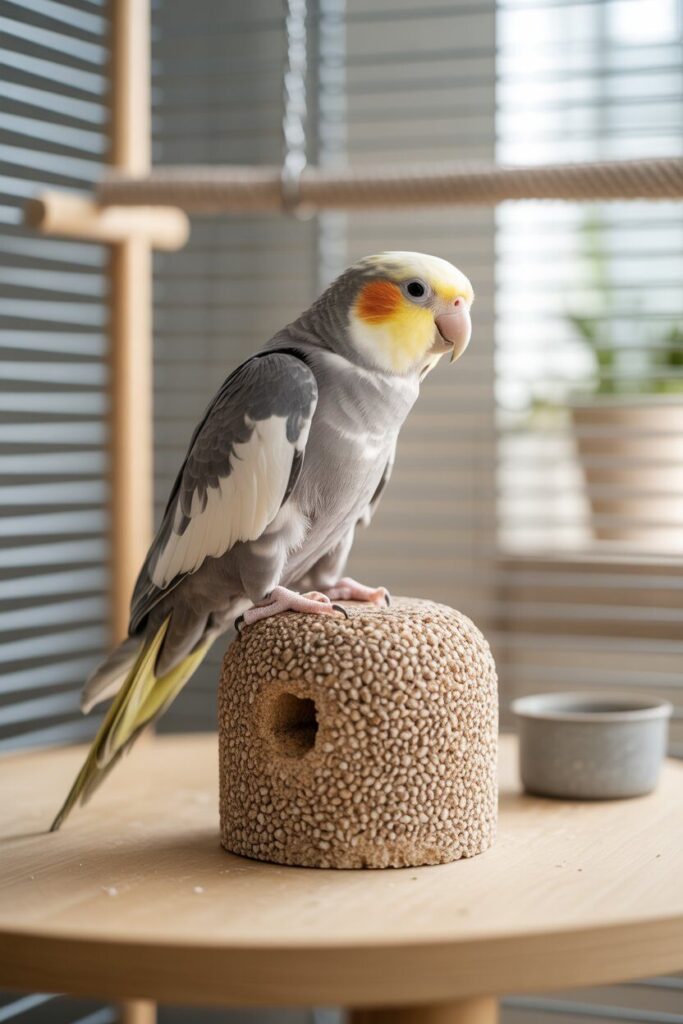
Birds don’t get pedicures at the spa, but they do need nail and beak maintenance. Ever noticed your bird’s nails scratching your skin during playtime? Ouch. That’s where gravel perches save the day.
Here’s why they matter:
- Natural Nail Trimming: The textured surface helps wear down nails naturally, reducing the need for stressful clipping sessions.
- Beak Conditioning: Birds rub their beaks on perches, and gravel textures help keep beaks smooth and shaped.
- Foot Health: Different textures and diameters exercise their feet, preventing pressure sores and arthritis-like issues.
- Mental Stimulation: A variety of perch textures and shapes keep birds mentally engaged.
Ever wondered what would happen if your bird never had a textured perch? Picture nails growing like tiny talons, curling awkwardly until they affect balance and grip. Not pretty, right?
Things to Look for in a Gravel Perch
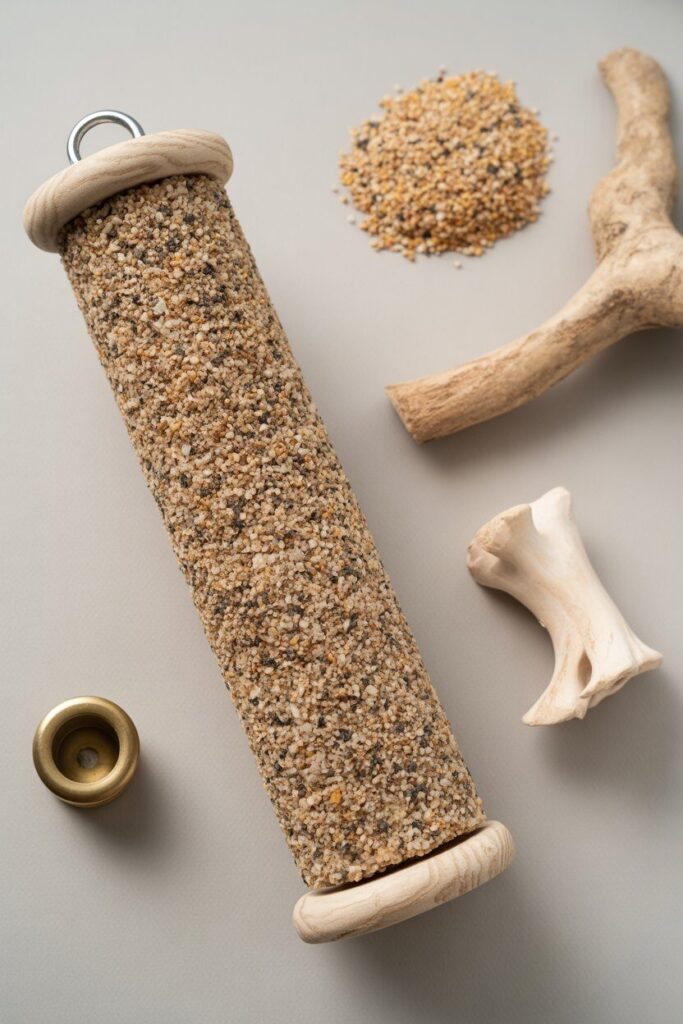
Not all gravel perches are created equal. Some are fantastic, others… let’s just say they look like medieval torture devices.
Here’s what you should check before buying:
- Size Matters: Choose the right diameter for your bird’s species. A parakeet doesn’t need a macaw-sized perch, and vice versa.
- Safe Materials: Look for perches coated in bird-safe grit. Avoid overly harsh surfaces that could cut your bird’s feet.
- Shape and Texture: Natural curves are better than straight, uniform designs because they mimic tree branches.
- Easy to Clean: Birds poop a lot (shocker), so you’ll want a perch that doesn’t turn into a sticky mess.
In my experience, the best gravel perches hit the sweet spot between effective grooming and comfortable grip. If your bird avoids a perch, it’s probably too rough.
Best Gravel Perches for Small Birds
If you’ve got budgies, finches, canaries, or lovebirds, you’ll need smaller, gentler perches.
Polly’s Tooty Fruity Perch

This one looks like a colorful candy stick, but it’s packed with minerals and bird-safe grit. It’s perfect for tiny feet and works wonders for keeping nails short. Plus, it comes in fun colors that brighten up the cage.
Pros:
- Gentle on small bird feet
- Provides minerals
- Easy to clean
Cons:
- May wear down faster than harder perches
JW Pet Sand Perch
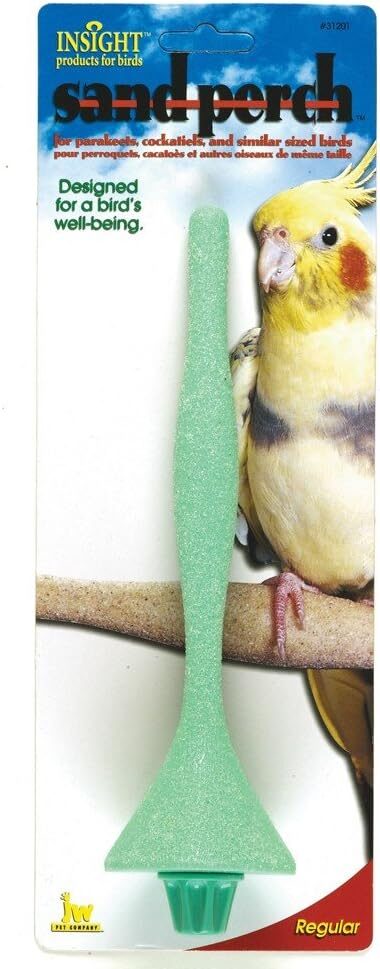
I’ve used this for parakeets, and it’s solid. It attaches easily to cages and has a nice textured surface that keeps nails filed.
Pros:
- Affordable
- Durable design
- Textured enough for nail care
Cons:
- Only comes in straight design
Small birds love variety, so I usually mix one gravel perch with a couple of wooden perches for comfort. Balance is key.
Best Gravel Perches for Medium Birds
Cockatiels, conures, Quakers, and ringnecks fall into this category. They need something a little sturdier but not overly rough.
Kaytee Lava Perch
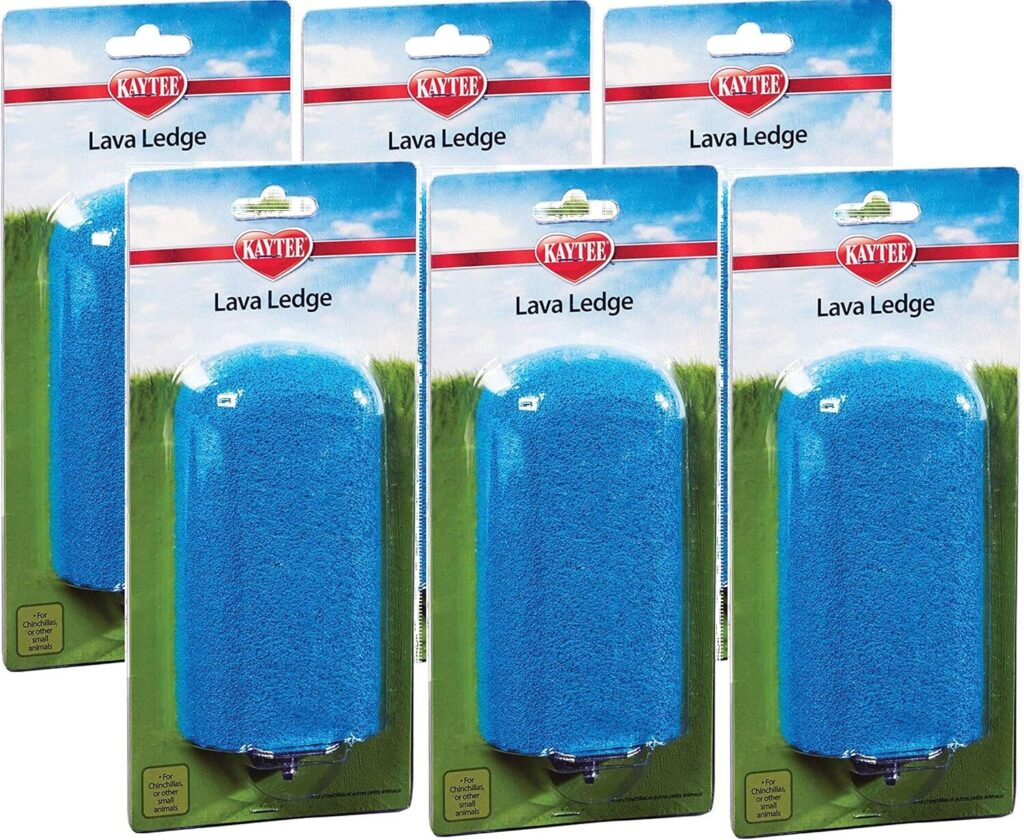
This perch combines volcanic rock texture with fun shapes. It doubles as a chew toy and a grooming tool. My conure went nuts for it, constantly rubbing his beak and hopping on and off.
Pros:
- Fun shapes for climbing
- Encourages chewing
- Long-lasting material
Cons:
- Can be too abrasive if it’s the only perch in the cage
Polly’s Pastel Perch

This one is gentler but still effective. The pastel color options are nice if you don’t want your cage looking like a circus.
Pros:
- Comfortable grip
- Effective for medium nails
- Attractive design
Cons:
- Slightly pricier than basic models
If you’ve ever wrestled a cockatiel to trim its nails, you’ll know why these perches feel like lifesavers.
Best Gravel Perches for Large Birds
Now, if you own an African grey, Amazon, or macaw, you’ll need the heavy-duty stuff. These birds have strong feet and serious beaks, so their perches must match that power.
Polly’s Cuttlebone Perch

This perch is genius. It combines gravel with cuttlebone, which provides calcium while conditioning beaks and nails. My friend’s African grey practically lives on this thing.
Pros:
- Dual purpose (calcium + grooming)
- Strong enough for large birds
- Natural shape
Cons:
- Heavier, so you need a sturdy cage bar
Superoost Perch
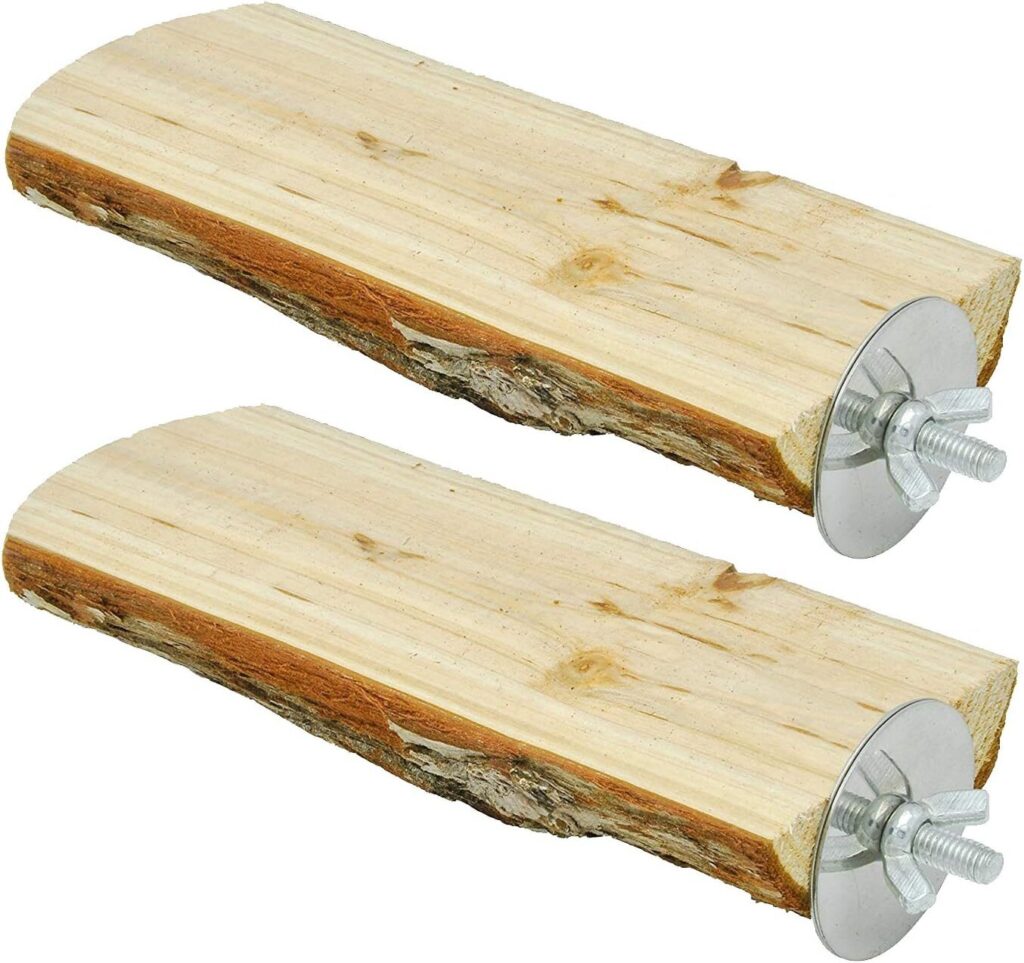
The name says it all. This is built for big birds and handles their weight without bending. It’s textured but not overly harsh, making it a good daily perch.
Pros:
- Very durable
- Safe for large species
- Easy to attach
Cons:
- Bulkier design
Large birds can destroy cheap perches in days. Trust me, spending a little extra upfront saves you from replacing them constantly.
How to Use Gravel Perches Safely
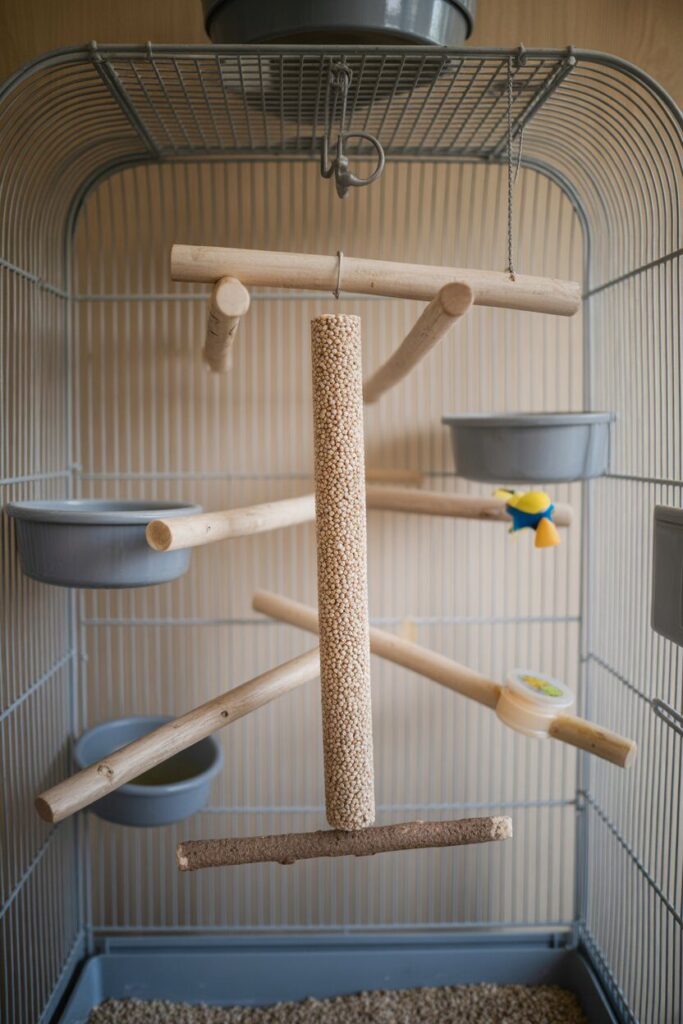
You can’t just toss in a gravel perch and call it a day. Birds need variety and balance. Imagine wearing steel-toed boots all day. Helpful, sure, but not exactly comfy 24/7.
Tips for safe use:
- Mix Perch Types: Combine gravel perches with natural wood, rope, or plastic perches.
- Limit Exposure: Don’t make gravel perches the only perches in the cage. One or two are enough.
- Watch for Overuse: If you notice sore spots or irritation, remove the perch immediately.
- Place Strategically: Put gravel perches near food or water bowls so your bird uses them casually.
- Clean Regularly: Scrub off droppings and grime to prevent bacteria buildup.
Ever had a bird give you the side-eye because you rearranged the cage? Yeah, they notice. Introduce new perches gradually so they don’t get suspicious.
My Personal Take on Gravel Perches
I’ll be honest: the first time I bought a gravel perch, I thought it was ugly. Like, “Why would I put this concrete-looking stick in my bird’s cage?”
But after a few weeks, I noticed my cockatiel’s nails weren’t scratching me anymore. He looked more comfortable, and trimming became less of a battle.
In my opinion, gravel perches aren’t optional—they’re essential. But they’re also not magic. You still need to monitor your bird’s health, trim nails occasionally, and mix perch types for the best results.
Would I recommend them? Absolutely. Just don’t go overboard and turn your bird’s cage into a rock quarry.
Conclusion
Gravel perches may not be glamorous, but they’re one of the best investments you can make for your bird’s health and happiness.
From trimming nails to conditioning beaks and keeping feet strong, these perches do a lot of behind-the-scenes work that makes your bird’s life easier—and yours too.
The trick is picking the right perch for your bird’s size, using it alongside other types, and paying attention to how your bird responds.
A happy bird means fewer scratches for you, fewer stressful grooming sessions, and a cage setup that keeps everyone smiling.
So if you’re still debating whether gravel perches are worth it, my advice is simple: try one. Your bird’s feet, beak, and overall mood will thank you. And hey, your arms might thank you too when those nails stop feeling like tiny daggers.
Are gravel perches safe for all bird species?
Gravel perches are usually safe for most pet birds. However, size, texture, and usage matter a lot. A perch that’s too rough or the wrong diameter can strain your bird’s feet.
Choose carefully. Small birds, like budgies or finches, need finer grit perches. Larger parrots require sturdier options that won’t crumble.
Moderation is key. Avoid having your bird stand on gravel all day. Mix gravel perches with natural wood or rope options.
This gives your bird a variety of textures. This way, you can prevent sore feet while still enjoying benefits for nails and beaks.
How many gravel perches should I put in my bird’s cage?
Less is more with gravel perches. One or two usually suffice, depending on cage size. If you fill the cage with them, your bird will miss softer spots and may get irritated feet.
Think of gravel perches as exercise gear: useful in moderation, but uncomfortable if overused.
Instead, place one gravel perch where your bird likes to hang out. Consider adding a second at a different height.
Mix them with rope or natural wood perches for balance. Your bird will use the gravel perch when needed and rest on softer options at other times.
Do gravel perches replace the need for nail trimming?
Gravel perches can reduce nail trimming, but they don’t stop it entirely. Some birds grow nails faster due to genetics, diet, and activity. If your bird is active and uses the gravel perch often, trimming may be rare.
However, don’t think you’ll never need to do nail care again. Watch the nail length and be ready to trim if they get too sharp.
In my experience, gravel perches save time and stress. They work best with a complete care routine, not as a total replacement.
Can birds sleep on gravel perches at night?
It’s not a good idea to let birds sleep on gravel perches for long. The rough texture can be uncomfortable, and pressure overnight may hurt their feet. Just like you wouldn’t sleep on rocks, your bird shouldn’t either.
Instead, offer softer wood or rope perches for sleeping. Use gravel perches as daytime spots.
Birds move around during the day, so they’ll use the gravel enough to benefit from it without overdoing it. A mix of perch types is the healthiest choice.
How often should I replace gravel perches?
Gravel perches don’t last forever. This is especially true if your bird likes to chew or spends a lot of time on them.
Over time, the surface can become smooth, crack, or flake. When this happens, the perch stops working well and might be uncomfortable or unsafe for your bird.
A good rule is to check your perches during weekly cage cleanings. If you see they’re losing grit, cracking, or collecting stubborn debris, it’s time to replace them.
Regularly rotating perches also keeps your bird’s space fresh and fun, which is great for their health and happiness.
